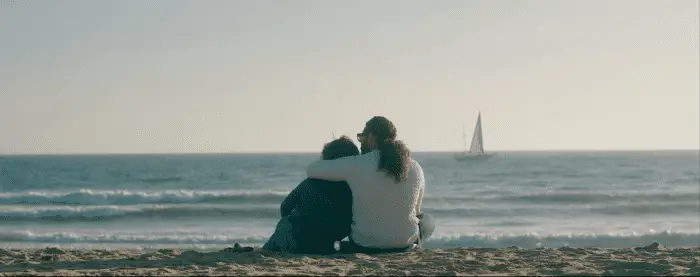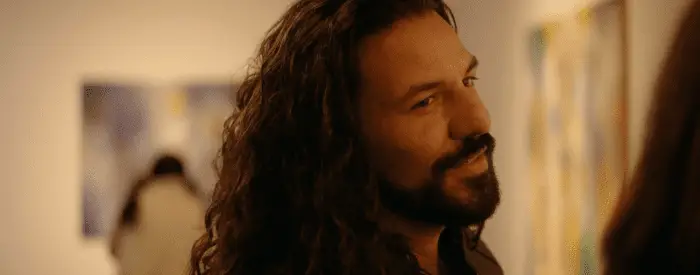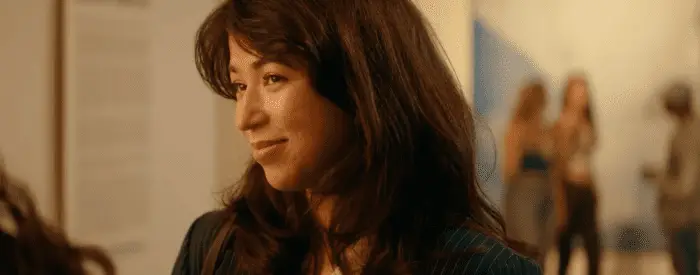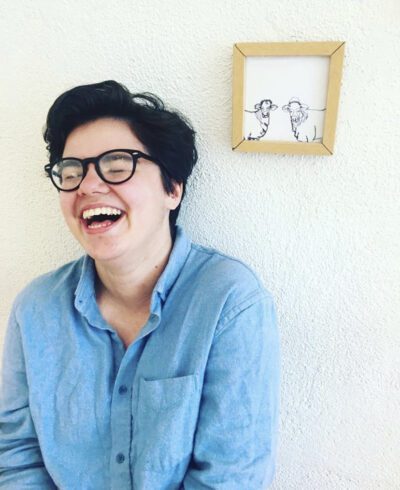En La Arena is an upcoming short film from writer/director/co-producer Frankie Garcés and co-producer/actor Arsenio Castellanos. The film is centered on two young people, Javier and Cassandra, at three different points in their life. They are growing up in the Westside of Los Angeles in the 90s and early-2000s as it is experiencing the effects of gentrification. En La Arena also focuses on how hard it can be to pursue a creative career path when the people in your life do not understand the artist’s calling.
Castellanos and Garcés are just two examples of the emerging talents featured in En La Arena. The short was made in collaboration with The Pico Youth and Family Center and Garcés’s Good Omens Production company. En La Arena is the product of trailblazing storytellers who want to have the spotlight shined on their town and help the next generation of filmmakers following behind. Film Obsessive sat down with Castellanos and Garcés to chat about En La Arena, their creative journeys, and the powerful impact of representation. (The transcript has been edited for length and clarity.)
Film Obsessive: How did you both fall in love with film and performing?
Frankie Garcés: That story goes back to childhood. I was a big musical theater fan. Gene Kelly, Fred Astaire, Dick Van Dike. Those were my idols growing up. And my mom took me to see a play when I was five years old at the only local theater in the Pico neighborhood. You know, falling in love with the magic of theater, the stage, singing, dancing, and then that kind of grew into just an appreciation of storytelling, whether I was on stage in front of the camera, behind the camera. And that’s kind of my passion now, just telling provocative and impactful stories.
Arsenio Castellanos: For me, it does go back when I was a little kid, too. When I moved to Hawthorne, there was this place called Movie Time, and it was like a mom and pop type of Blockbuster that had VHS and DVDs. People don’t know what that is now, but I would rent movies like clockwork. That’s where I fell in love with film. I finally stumbled into a theater class, and that’s where the love of it grew even more. I put it together. This theater thing is the same as what acting is in movies and it just bloomed from there.
For the project of En La Arena, it was written by Frankie, but it was co-produced by the two of you. So how did you guys come to meet? How did this whole relationship start?
Castellanos: Yeah, how did we meet, Frankie?
Garcés: Not as far back as childhood, but it definitely feels that way now. Arsenio and I have been friends for, I’d say, six years. Is that right? We were both working at a bar in Westwood, and it was a speakeasy, so we were below this popular sports bar and people didn’t really know we were there. So it was just him and I for hours on end and we had a great time. That’s kind of where we recognized, like, we’re both actors, you know, we’re both locals to L.A., to California, and we’re both Latinos. So that, you know, brotherly love grew really quickly. And so from there, I think, is when we started to plan, like, all right, what is something that we can come together and tell a story that relates to the both of us and is impactful in the way that we like to tell a story.

And then did you come to Arsenio with this idea of a multi decade spanning story? It feels to me it felt very much like if you took, like the Before Sunrise trilogy and condensed it down to 16 minutes. So kind of talk me through that inspiration and then did you write the role specifically for Arsenio?
Garcés: Not initially. We were co-writing a feature together, a heist film, which is still in development. And just one night I was going through something personally, and I completely wrote this idea of a script. I just wrote it on my iPhone and my notes page at like, I don’t know, like 1 a.m. or 2 a.m. or something on like a Friday or Saturday. And I sent it all to him in a big text. And I was just like, hey, we should pivot, Let’s do this. Here’s how we get the finances, here’s how we can get the crew, blah, blah, blah. And his reply was like, hey, I’m out partying right now.
Castellanos: I remember that!
Garcés: Here’s this, you know, manuscript of a text message and it’s a Saturday. He was like, well, like, I’ll read this in the morning, dude. And so from there, you know, the collaboration with the writing, like the story is very personal. But we had initially wrote it for the East L.A. community, Echo Park, Silverlake, because they have very similar story to the Pico neighborhood in the sense that it’s a lot of gentrification, a lot of over-development happening, and displacement of the locals that are native to this land and the culture there. And over time, you know, I’ve been working with this youth center in Santa Monica called the Pico Youth and Family Center, we developed a really close relationship between my company and theirs. And they asked what we were working on, and I showed it to them and they were like, you know, we would love to do something like this. Is it possible for us to make something for the Westside? Can you make it for the Westside? I was like, that’s there’s an idea. And so I started to rewrite and it really grew into a more personal story. I mean, this is where I grew up. We filmed all along the Westside from Malibu, Venice, Santa Monica, deep into the Palisades. It made a lot more sense once we brought it home.

Three actors play the same characters in different decades. And Arsenio, I want to start with you. Did you get to see the other Javiers? How did it work? You all had the same essence.
Castellanos: As a co-producer, Frankie and I were always communicating back and forth. And he did say, I think it would behoove you to have this conversation. So there’s like not just a linear, but there’s a, there’s like it so that it makes sense. And the little Javier is my nephew. And then Gabe, the teenager, he’s such a wonderful actor. I love talking to him back and forth. Watch out for that guy, he’s got a wonderful career ahead of him. But it was awesome to talk to him and just to talk to my nephew because he doesn’t know what he’s doing, but he’s just living and he’s just he was just so present and wonderful to work with.
Was it intimidating to feel like you had to finish what the other two essentially had built, or was it kind of like a little easier because you were the most mature version of Javier that we get to see?
Castellanos: A little bit of intimidation here and there. I always, especially when I’m on set, there’s always going to be butterflies. But I know what the mission was to just represent that character and to do it. The way that we wanted to do it. Like as outliers and these Latino filmmakers trying to tell this story and, and through all the ideas that we had.
Garcés: Arsenio and I both, you know, we have our roots in the theater and so the process of developing this project was a very organic one. We had chemistry reads with some of the actors. We also had rehearsals prior to our first shot, and so everybody really understood the mission of the film as well as their own roles within that. I’m an actor’s director, so I get inspired when an actor has an instinct or likes to, you know, debate on some of the character’s points of views or how to approach, you know, their impulses. So, yeah, it was a very family oriented kind of collaboration and everybody kind of understood the mission.
Can you talk a little bit about the Pico Youth Center that you’re working with?
Garcés: They’re an amazing youth program out here in Santa Monica, in the heart of the Pico neighborhood, which is, you know, a conglomerate of black and brown immigrant and working class families on the Westside. The Pico Youth and Family Center started as a gang prevention and intervention center about 20 years ago. And, you know, they were really a pillar of change and transformation mediation during the, you know, the early nineties into the early 2000s when there was quite a lot of gang violence all over the Westside. Since then, you know, there’s been plenty of development on the Westside. When I say gangs in Santa Monica or Culver City, people kind of are like, What? So there was a lot of kind of erased history over time. And what they’re doing now is they’ve evolved into more of a digital academy and cultural hub. And that’s part of what Good Omen Pictures is helping them transform into. So we came in, we’ve renovated a bunch of their studio spaces. We’ve brought in partners from rental gear companies to studios to come in and help support this youth center. And we placed some of the students into paid partnerships, either with these partners or with my company and brought them onto set so that they can get experience. So we’re really doing a full in-depth refurbishing of what they’ve got going on.

That’s incredible. It kind of brings me to something that the teenage Cassandra talks about when they make their promise that no matter what, they’re going to pursue their passions and in the arts. It’s a very difficult field to get started in and be successful. What have you both found to be the hardest and easiest parts of pursuing this art career?
Castellanos: Well, it’s wild because we had a conversation yesterday, Frankie and I. I was a recurring costar on this amazing show called Snowfall. And then I have to go back to bartending. And it’s like, man, that’s just the dues that need to be paid. You keep going and you try to figure out and navigate this thing called life in the industry. And it’s just been a roller coaster of emotions and a lot of ups and downs. You just stick it out and you find your tribe and you find the people that respect and love you and are willing to go to battle with you. And that person is Frankie for me. We’re just in this together and it’s very, very, very hard. It has created a thick skin and we have to have a thin skin as well, because vulnerability is a big part of it as well. Like just sharing ourselves, sharing our hearts. There’s a saying: have the hide of a rhino and the soul of a rose in this industry.
Garcés: I love that man. I don’t know if I can top that. For me, it’s I’ve always known what I’ve wanted to do since I entered that theater at age five. It’s never been a question of time for me. You know, I’m going to do this till I pass. Whether I achieve whatever it is I’m trying to achieve or not. It’s just who I am, you know, This is how I breathe, essentially, telling a story is part of my identity. But I also had the pleasure and the privilege of attending, you know, conservatory schools. I went to Los Angeles County High School for the Arts. It’s a public school, but it’s all the way in East L.A. So I would commute two buses and a train 6 a.m. from Santa Monica to get there, and it was life altering. It really put wind in my sails and showed me not just the beauty of the craft, but the reality of the business. Often, you know, life comes in waves. You know, sometimes you can have a nice wave come and you’re riding it. All this success, all these things are happening, but that wave is naturally going to subside and then it’s going to be flat water for some time during those moments. That is the universe telling you not to struggle, not to try to summon up another wave, but to be of service to those around you. When you start building your team, building your community, and uplifting those who are catching their own waves, the wave that comes back is going to be much larger and it’s going to be filled with a lot more friends and family and people who want to see you succeed.
And my last question for you guys is what are the plans for En La Arena?
Garcés: We just got an official selection to our first festival, the Micheaux Film Festival, which is an incredible festival. It’ll be at L.A. Live and I’m an alumni of that festival. I think my directorial debut was there in 2021, so I’m really excited to get back there. Noelle and Courtney, the founders of the festival, are incredible people and they really know how to throw a very resourceful and lively event. So I’m super stoked to come back for myself. But even more so, I’m excited to bring the students that worked on the film to their first ever film festival and see their film that they worked on on the big screen. Like that kind of representation, that kind of experience. It can be life altering.
Check out the trailer for En La Arena below and be sure to follow their Facebook page to stay up to date:




